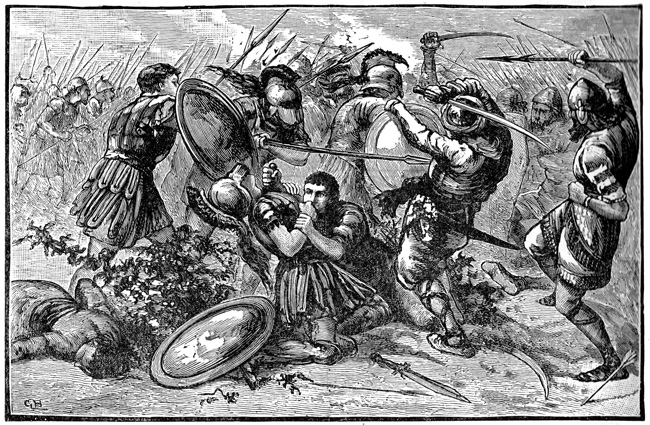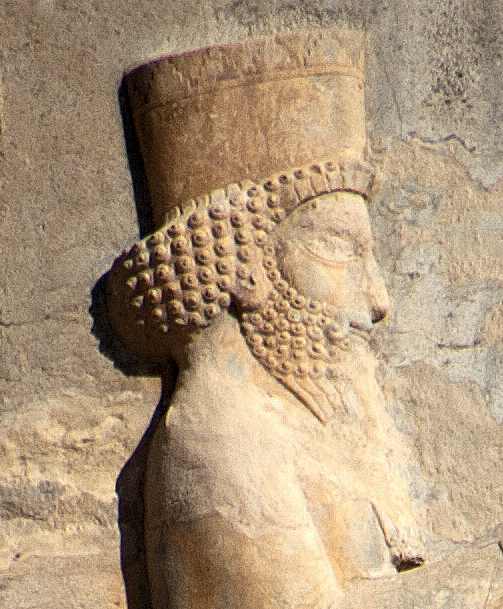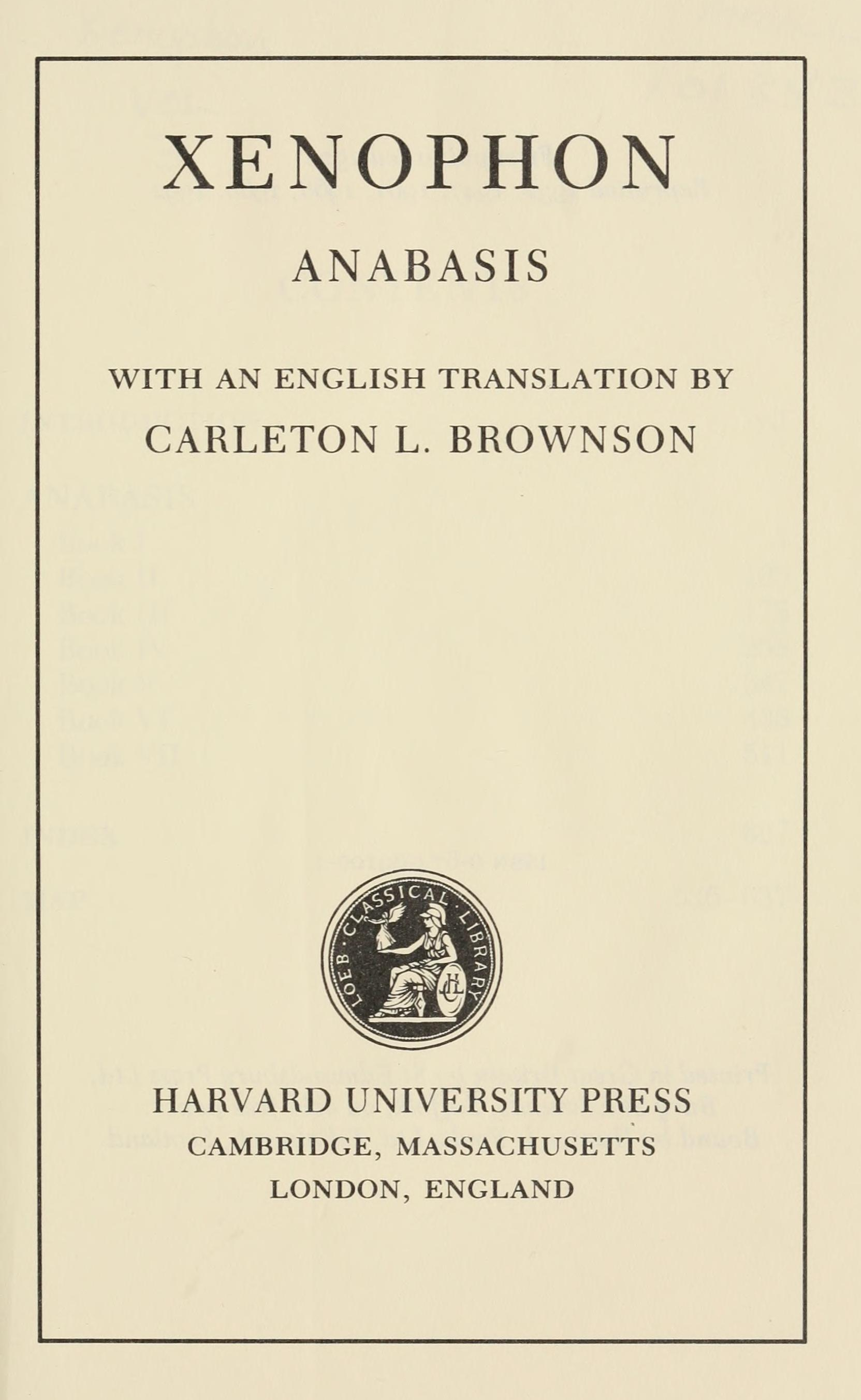|
Ariaeus
Ariaeus (fl. 401 BC – 394 BC) was a Persian general who fought alongside Cyrus the Younger at the Battle of Cunaxa and later was involved in the assassination of Tissaphernes. Life Ariaeus appears in historic records in 401 BC, in Xenophon's description of the events leading up to the Battle of Cunaxa. Xenophon noted that he was a friend of Cyrus and was said to be attracted to young boys, which was why he was an intimate of the young Thessalian general Menon. At the Battle of Cunaxa, he was Cyrus' second in command and commanded the left. According to Ctesias, he was alongside Cyrus, when Cyrus succeeded in wounding Artaxerxes, but this is unlikely. This would put him on the right alongside Cyrus, and Xenophon and Diodorus both agree he was on the left, which would have been some distance away. As soon as Ariaeus discovered that Cyrus was slain in battle, he retreated with the surviving Persian troops. After the battle, he offered to wait and return with the surviving ... [...More Info...] [...Related Items...] OR: [Wikipedia] [Google] [Baidu] |
Tissaphernes
Tissaphernes (; ; , ; 445395 BC) was a Persian commander and statesman, Satrap of Lydia and Ionia. His life is mostly known from the works of Thucydides and Xenophon. According to Ctesias, he was the son of Hidarnes III and therefore, the great grandson of Hydarnes, one of the six conspirators who had supported the rise of Darius the Great. Etymology ''Čiçafarnah'' (''čiça'' + ''farnah'') "with shining splendor": ''čiça'' is from the Proto-Indo-European adjective ''(s)koitrós'' 'bright'; ''farnah'' is equivalent to Avestan '' xvarənah'' 'fortune', 'glory', which appears as 'luminous'. ''čiθra'' means nature, specifically the animate nature. ''Čiça-'' is the Old Persian form of the Old Iranian term ''Čiθra-'', which is reflected in the Median form of the name, ''*Čiθrafarnah-'' (). Family and early life Tissaphernes was born in 445 BC. He belonged to an important Persian family: he was the grandson of Hydarnes, an eminent Persian general, who was the c ... [...More Info...] [...Related Items...] OR: [Wikipedia] [Google] [Baidu] |
Menon III Of Pharsalus
Meno ( /ˈmiːnoʊ/; Greek: Mένων, ''Menōn''; 423 – 400 BC), son of Alexidemus, was an ancient Thessalian political figure, probably from Pharsalus. He is famous both for the eponymous dialogue written by Plato and for his role as one of the generals leading different contingents of Greek mercenaries in Xenophon's ''Anabasis''. Meno is reported by both Xenophon and Plato to have been attractive and in the bloom of youth, not yet even having a beard, and was quite young at his death. He had many lovers, including Aristippus of Larissa, Tharypas, and Ariaeus the Persian. Classical accounts In Xenophon Meno's beginning and command Xenophon gives a strongly hostile description of Meno as a disreputable, ambitious and dishonest youth, willing to commit any injustice for advancement, and immeasurably greedy for wealth, although some modern scholars read Xenophon as being set on attacking Meno's character, and are unsure what credence to give his descriptions. Meno was only ... [...More Info...] [...Related Items...] OR: [Wikipedia] [Google] [Baidu] |
Battle Of Cunaxa
The Battle of Cunaxa was fought in the late summer of 401 BC between the Persian king Artaxerxes II and his brother Cyrus the Younger for control of the Achaemenid Empire, Achaemenid throne. The great battle of the revolt of Cyrus took place 70 km north of Babylon, at Cunaxa (), on the left bank of the Euphrates. The main source is Xenophon, a Greek soldier who participated in the fighting. Despite the success in the battle achieved by the interaction of the Ancient Greek mercenaries, Greek mercenaries and the Persian troops of Cyrus, the outcome of the battle and the death of the pretender to the throne led to the defeat of the entire uprising and forced Greeks to commit ''Anabasis (Xenophon), Anabasis''. Preparations Cyrus gathered an army of Greek mercenary, mercenaries, consisting of 10,400 hoplites and 2,500 light infantry and peltasts, under the Spartan general Clearchus of Sparta, Clearchus, and met Artaxerxes at Cunaxa. He also had a large force of levied troops under ... [...More Info...] [...Related Items...] OR: [Wikipedia] [Google] [Baidu] |
Socrates Of Achaea
Socrates () (c. 436 BC – 401 BC) was a Greek mercenary general from Achaea who traveled to Achaemenid Empire, Persia to fight at the Battle of Cunaxa. Xenophon describes him as brave in war and a reliable friend. Socrates was summoned by Cyrus the Younger, Cyrus, with whom he was already connected, to bring as many troops as he could muster under the pretense that Cyrus intended to attack Tissaphernes. Socrates had previously been besieging Miletus alongside Pasion the Megarian. Socrates brought Cyrus about 500 hoplites.Xenophon, ''Anabasis'' 1.2.3 Socrates and the other troops were only later told that Cyrus intended to seize the List of kings of Persia, Persian throne from his brother Artaxerxes II of Persia, Artaxerxes. Socrates fought at the Battle of Cunaxa and the Greek forces were able to drive the Persians into retreat, but Cyrus and his force faced heavy casualties and Cyrus himself was killed in battle. With Cyrus dead, the Greek troops were left in limbo, trying to mak ... [...More Info...] [...Related Items...] OR: [Wikipedia] [Google] [Baidu] |
Cyrus The Younger
Cyrus the Younger ( ''Kūruš''; ; died 401 BC) was an Achaemenid prince and general. He ruled as satrap of Lydia and Ionia from 408 to 401 BC. Son of Darius II and Parysatis, he died in 401 BC in battle during a failed attempt to oust his elder brother, Artaxerxes II, from the Persian throne. The history of Cyrus and of the retreat of his Greek mercenaries is told by Xenophon in his '' Anabasis''. Another account, probably from Sophaenetus of Stymphalus, was used by Ephorus. Further information is contained in the excerpts from Artaxerxes II's physician, Ctesias, by Photius; ''Plutarch’s Lives'' of Artaxerxes II and Lysander; and Thucydides' ''History of Peloponnesian War''. These are the only early sources of information on Cyrus the Younger. Biography According to Xenophon, Cyrus the Younger was born after the accession of his father in 424 BC. He had an elder brother, Arsicas (whose name changed to Artaxerxes II when he ascended the throne), and two younger bro ... [...More Info...] [...Related Items...] OR: [Wikipedia] [Google] [Baidu] |
Hellenica Oxyrhynchia
''Hellenica Oxyrhynchia'' is an Ancient Greek history of Greece in the late 5th and early 4th centuries BCE known only from papyrus fragments unearthed at Oxyrhynchus in Egypt. The author, whose name is not recorded in the surviving fragments, is usually known by scholars simply as the "Oxyrhynchus historian". Overview One of the two major fragments, called the ''London papyrus,'' found in 1906, deals with battles in the late Peloponnesian War, particularly the Battle of Notium. The other, the ''Florentine papyrus'', found in 1934, deals with events in the early 4th century BCE. The entire history seems to have been a continuation of Thucydides covering events from 411 BCE to 394 BCE, much like Xenophon's ''Hellenica'' ( a fragment of which has also been found at Oxyrhynchus). The discovery of the first papyrus in 1906 led to a shift in the degree of credence that historians assigned to the ancient sources of the period. In the 19th century, Xenophon, a contemporary of the eve ... [...More Info...] [...Related Items...] OR: [Wikipedia] [Google] [Baidu] |
4th-century BC Deaths
The 4th century was the time period from 301 CE (represented by the Roman numerals CCCI) to 400 CE (CD) in accordance with the Julian calendar. In the West, the early part of the century was shaped by Constantine the Great, who became the first Roman emperor to adopt Christianity. Gaining sole reign of the empire, he is also noted for re-establishing a single imperial capital, choosing the site of ancient Byzantium in 330 (over the current capitals, which had effectively been changed by Diocletian's reforms to Milan in the West, and Nicomedeia in the East) to build the city soon called Nova Roma (New Rome); it was later renamed Constantinople in his honor. The last emperor to control both the eastern and western halves of the empire was Theodosius I. As the century progressed after his death, it became increasingly apparent that the empire had changed in many ways since the time of Augustus. The two-emperor system originally established by Diocletian in the previous century fel ... [...More Info...] [...Related Items...] OR: [Wikipedia] [Google] [Baidu] |
5th-century BC Births
The 5th century is the time period from AD 401 (represented by the Roman numerals CDI) through AD 500 (D) in accordance with the Julian calendar. The 5th century is noted for being a period of migration and political instability throughout Eurasia. It saw the collapse of the Western Roman Empire, which came to a formal end in 476 AD. This empire had been ruled by a succession of weak emperors, with the real political might being increasingly concentrated among military leaders. Internal instability allowed a Visigoth army to reach and ransack Rome in 410. Some recovery took place during the following decades, but the Western Empire received another serious blow when a second foreign group, the Vandals, occupied Carthage, capital of an extremely important province in Africa. Attempts to retake the province were interrupted by the invasion of the Huns under Attila. After Attila's defeat, both Eastern and Western empires joined forces for a final assault on Vandal North Africa, but ... [...More Info...] [...Related Items...] OR: [Wikipedia] [Google] [Baidu] |
Military Leaders Of The Achaemenid Empire
A military, also known collectively as armed forces, is a heavily armed, highly organized force primarily intended for warfare. Militaries are typically authorized and maintained by a sovereign state, with their members identifiable by a distinct military uniform. They may consist of one or more military branches such as an army, navy, air force, space force, marines, or coast guard. The main task of a military is usually defined as defence of their state and its interests against external armed threats. In broad usage, the terms "armed forces" and "military" are often synonymous, although in technical usage a distinction is sometimes made in which a country's armed forces may include other paramilitary forces such as armed police. Beyond warfare, the military may be employed in additional sanctioned and non-sanctioned functions within the state, including internal security threats, crowd control, promotion of political agendas, emergency services and reconstruction, pro ... [...More Info...] [...Related Items...] OR: [Wikipedia] [Google] [Baidu] |
Hellenica
''Hellenica'' () simply means writings on Greek (Hellenic) subjects. Several histories of the 4th-century BC Greece have borne the conventional Latin title ''Hellenica'', of which very few survive.Murray, Oswyn, "Greek Historians", in John Boardman, Jasper Griffin and Oswyn Murray, ''Greece and the Hellenistic World'' (Oxford History of the Classical World I, 1986; 1988) p. 192.Thomas, "Introduction," xxvi. The most notable of the surviving histories is the ''Hellenica'' of the Ancient Greek writer Xenophon (also known as ''Hellenika,'' or ''A History of My Times''). The work was intended as a continuation of Thucydides' ''History of the Peloponnesian War'', which was left unfinished and ends abruptly in the year 411 BC.Xenophon (2010), Thomas, David, "Introduction," p. x. Xenophon's ''Hellenica'' covers the years 411-362 BC, through the end of the Peloponnesian War and its aftermath.Thomas, "Introduction," ix. ''Hellenica'' is usually considered to be a difficult work for modern ... [...More Info...] [...Related Items...] OR: [Wikipedia] [Google] [Baidu] |
Anabasis (Xenophon)
''Anabasis'' ( ; ; ) is the most famous work of the Ancient Greece, Ancient Greek professional soldier and writer Xenophon. It gives an account of the expedition of the Ten Thousand (Greek), Ten Thousand, an army of Greek mercenaries hired by Cyrus the Younger to help him seize the throne of Achaemenid Empire, Persia from his brother, Artaxerxes II, in 401 BC. The seven books making up the ''Anabasis'' were composed . Although as an Ancient Greek vocabulary word () meaning 'embarkation', 'ascent' or 'mounting up', the title ''Anabasis'' has been rendered by some translators as ''The March Up Country'' or as ''The March of the Ten Thousand''. The story of the army's journey across Asia Minor and Mesopotamia is Xenophon's best known work and "one of the great adventures in human history". Authorship Xenophon, in his ''Hellenica#Xenophon's Hellenica, Hellenica'', did not cover the retreat of Cyrus but instead referred the reader to the ''Anabasis'' by "Themistogenes of Syracuse"� ... [...More Info...] [...Related Items...] OR: [Wikipedia] [Google] [Baidu] |
Xenophon
Xenophon of Athens (; ; 355/354 BC) was a Greek military leader, philosopher, and historian. At the age of 30, he was elected as one of the leaders of the retreating Ancient Greek mercenaries, Greek mercenaries, the Ten Thousand, who had been part of Cyrus the Younger's attempt to seize control of the Achaemenid Empire. As the military historian Theodore Ayrault Dodge wrote, "the centuries since have devised nothing to surpass the genius of this warrior". For at least two millennia, it has been debated whether or not Xenophon was first and foremost a general, historian, or philosopher. For the majority of time in the past two millennia, Xenophon was recognized as a philosopher. Quintilian in Institutio Oratoria, ''The Orator's Education'' discusses the most prominent historians, orators and philosophers as examples of eloquence and recognizes Xenophon's historical work, but ultimately places Xenophon next to Plato as a philosopher. Today, Xenophon is recognized as one of the gr ... [...More Info...] [...Related Items...] OR: [Wikipedia] [Google] [Baidu] |









